Spazio: ultima frontiera. Credere che si sia soli nell'universo è come credere che la Terra sia piatta. Come disse l'astrofisico Labeque al palazzo dell'UNESCO, durante il congresso mondiale del SETI di Parigi del Settembre 2008, " SOMETHING IS HERE", "Qualcosa è qui", e I TEMPI SONO MATURI per farsene una ragione. La CIA, l'FBI, la NSA, il Pentagono, e non solo, lo hanno confermato!
Statistiche
Wednesday, March 31, 2021
Friday, March 26, 2021
Thursday, March 25, 2021
Multiple Destroyers Were Swarmed By Mysterious 'Drones' Off California Over Numerous Nights

The disturbing series of events during the summer of 2019 resulted in an investigation that made its way to the highest echelons of the Navy.
In July of 2019, a truly bizarre series of events unfolded around California’s Channel Islands. Over a number of days, groups of unidentified aircraft, which the U.S. Navy simply refers to as ‘drones’ or 'UAVs,' pursued that service's vessels, prompting a high-level investigation.
During the evening encounters, as many as six aircraft were reported swarming around the ships at once. The drones were described as flying for prolonged periods in low-visibility conditions, and performing brazen maneuvers over the Navy warships near a sensitive military training range less than 100 miles off Los Angeles. The ensuing investigation included elements of the Navy, Coast Guard, and the Federal Bureau of Investigation (FBI). The incidents received major attention, including from the Chief of Naval Operations—the apex of the Navy's chain of command.
The following is our own investigation into these events, during which we discovered these events were far more extensive in scale than previously understood.
A Strange Story Emerges
Last year, documentary filmmaker Dave Beaty uncovered initial details about the events, centering on the Arleigh Burke class destroyer USS Kidd (DDG-100). That initial account described a tense encounter, culminating in the deployment of onboard intelligence teams.

USS Kidd
New documents significantly expand the public's knowledge of the scope and severity of that incident and reveal others that occurred around the same time. These details come largely from our Freedom of Information Act (FOIA) requests, which resulted in the disclosure of deck logs from the ships involved. Additionally, our investigation utilized hundreds of gigabytes of automatic identification system (AIS) ship location data to forensically reconstruct the position of both military and civilian ships in the area during this strange series of events. By using the USS Kidd's position as a starting point, we were able to identify several other ships in close proximity to it during the incidents in question, including U.S. Navy destroyers USS Rafael Peralta, USS Russell, USS John Finn, and the USS Paul Hamilton. Subsequent FOIA requests for these ships' records allowed us to build a composite picture of the events as a whole.By using the USS Kidd's position as a starting point, we were able to identify several other ships in close proximity to it during the incidents in question, including U.S. Navy destroyers USS Rafael Peralta, USS Russell, USS John Finn, and the USS Paul Hamilton. Subsequent FOIA requests for these ships' records allowed us to build a composite picture of the events as a whole.
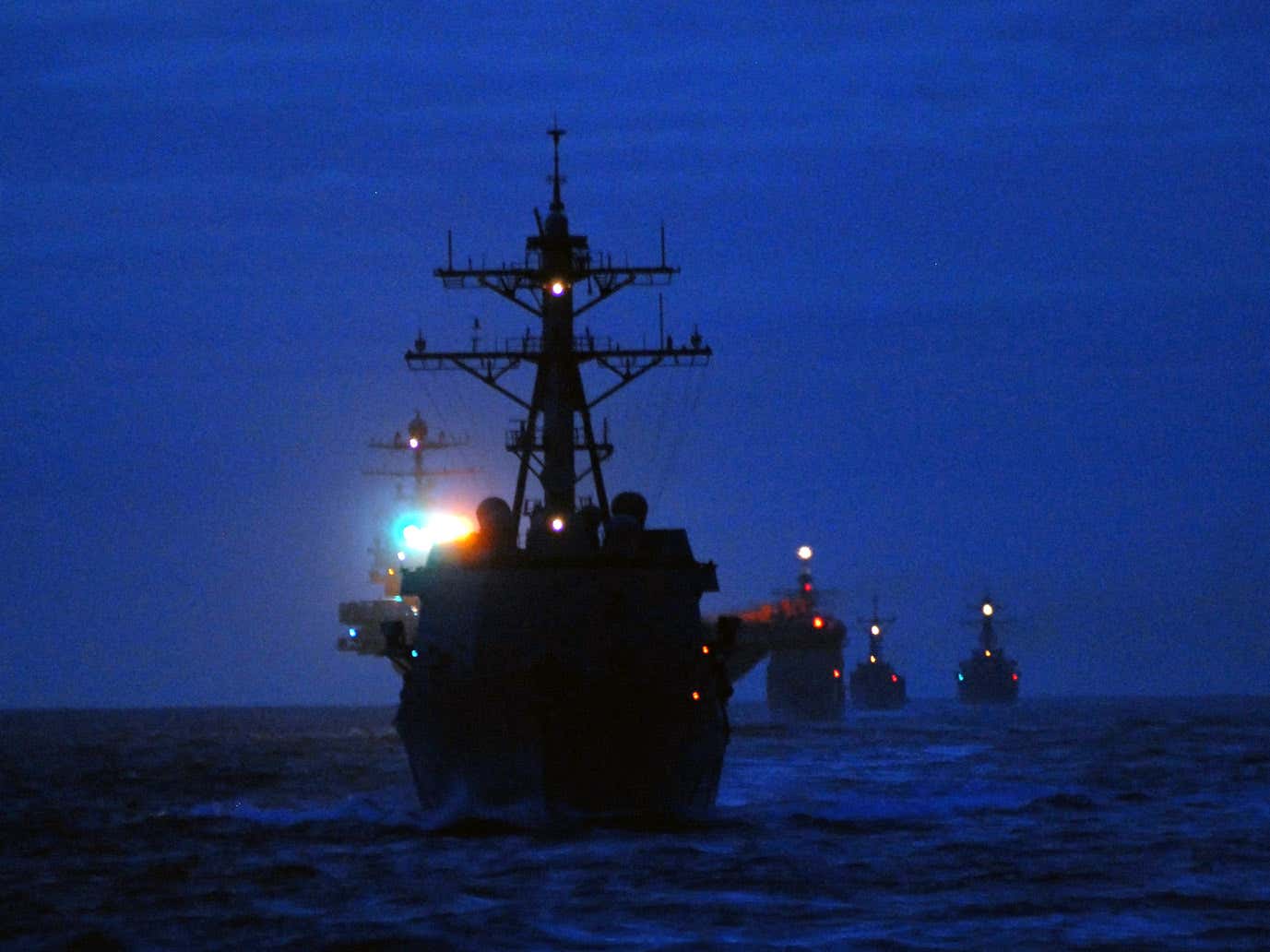
Night One: July 14th, 2019
It appears the incidents began with an initial ‘UAV’ sighting by the USS Kidd around 10:00 PM on the night of July 14th, 2019. Deck logs like the one below provide information about the course and speed of the ship. Additionally, they record any other relevant information about unusual events or changes in the ship's behavior. This log records the first drone sighting:

As previously reported, two drones, typically described as UAVs or unmanned aerial vehicles throughout the logs, were spotted by the Kidd. The Ship Nautical Or Otherwise Photographic Interpretation and Exploitation team, or "SNOOPIE team," refers to an onboard photographic intelligence team tasked with documenting unknown contacts, events of interest, and other objects of interest on short order.

A member of a destroyer's SNOOPIE team with a video camera in hand.
Though an Aegis-equipped ship like the USS Kidd has some of the most sophisticated sensors on earth, sailors equipped with consumer-grade cameras act as a kind of nimble spotting and event recording team, able to quickly adapt to changing conditions while providing situational awareness and recording what they see through traditional video and photo methods. You can see a SNOOPIE team in action and one of their products in the video below:
Moments after the sighting on July 14th, the USS Kidd entered into a condition of restricted communications designed to enhance operational security and enhance survivability. This is noted throughout many of the logs as "River City 1." During the events, the ships often engaged “emissions control,” or EMCON, protocols designed to minimize their electronic emissions profile.
Less than 10 minutes after the sighting, the USS Kidd advised the USS Rafael Peralta of the situation. The USS Rafael Peralta logs show that at around 10:00 PM it activated its own SNOOPIE team. They also show that reports of additional sightings were coming in from the USS John Finn.

For its part, the logs of the USS John Finn simply reported possible UAV activity, and deactivation of the ship's AIS transponder system. In fact, the selective deactivation of AIS was a challenge for us in reconstructing ship positions, as we sometimes had to rely on cross-comparison of deck logs to locate the position of the ships.
Shortly after the initial sighting, a red flashing light was spotted.

Among the more dramatic entries in the logs from this incident is the one below from the USS Rafael Peralta, describing a white light hovering over the ship's flight deck.

The log reflects that the drone managed to match the destroyer's speed with the craft moving at 16 knots in order to maintain a hovering position over the ship’s helicopter landing pad. To further complicate what was already a complex maneuver, the drone was operating in low visibility conditions (less than a nautical mile) and at night.
By this point, the encounter had lasted over 90 minutes—significantly longer than what commercially available drones can typically sustain.
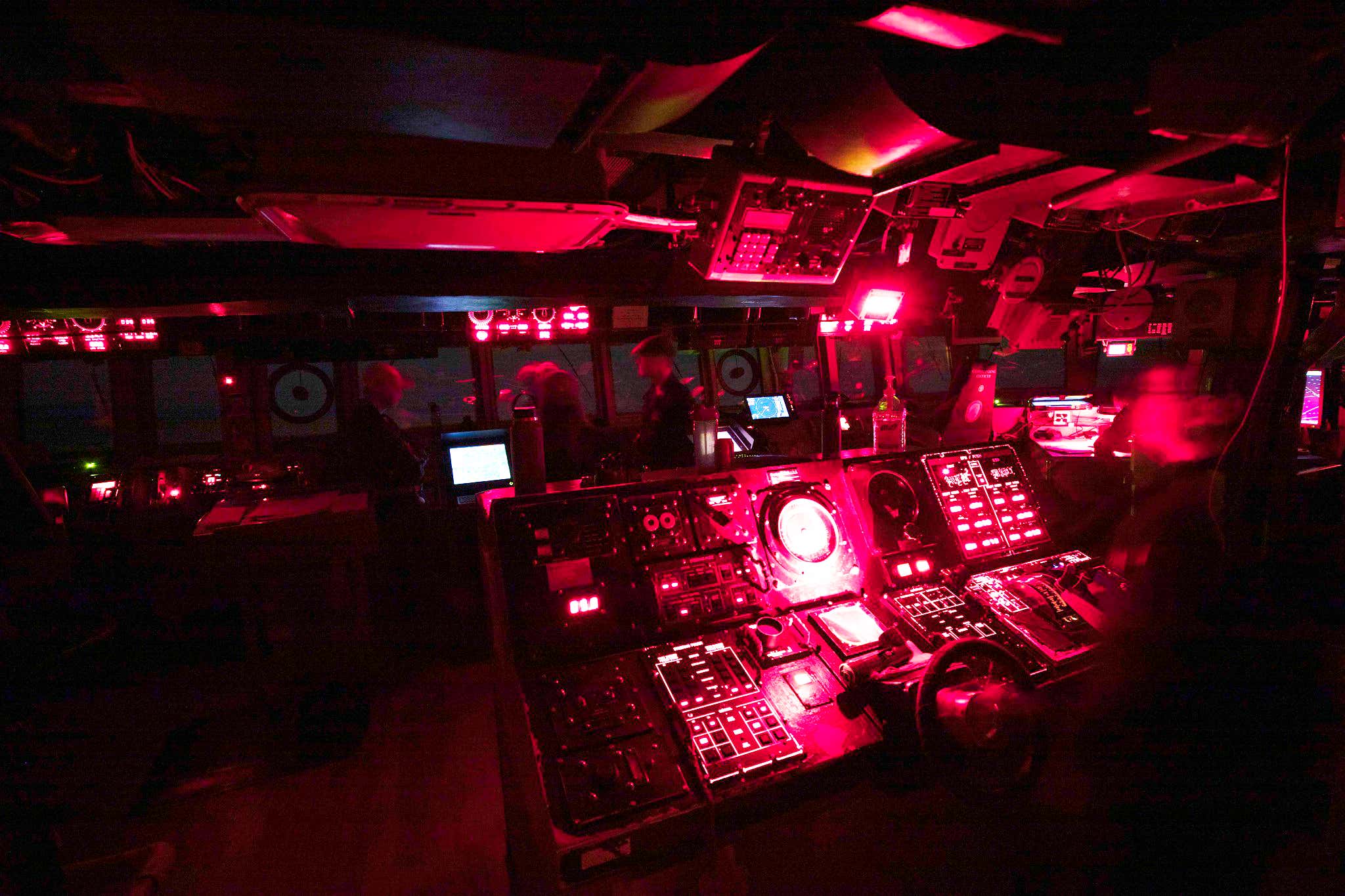
The red-lit bridge of an class destroyer at night.
According to AIS data, few civilian ships were in the immediate vicinity. AIS is not strictly mandatory in all cases, and can be turned off, so it is possible other vessels could have been nearby, as well. The civilian bulk carrier Bass Strait, cited later in the investigation, was situated towards the northern edge of the encounter area. A Liberian-flagged oil tanker, the Sigma Triumph, was just south of the position of the three destroyers. The ORV Alguita, a 50-foot catamaran, briefly a subject of interest in the official investigation that would come, was just off the western tip of San Clemente Island. Importantly, San Clemente Island is owned by the Navy and is frequently used for military training and testing purposes.
The following map shows maritime traffic around the ports of Los Angeles and San Diego on July 14th. The position of each ship at 10:00 PM is marked with a black indicator, and the track of the ship before and after the incident time is marked with colored dots. The approximate positions of each cluster of ships are numerically marked.

The two groups of destroyers and the ORV Alguita form a roughly triangular shape with each side approximately 50 nautical miles long, containing an area just over 1000 square nautical miles. The Bass Strait and the USS Paul Hamilton were in relatively close proximity at marker one. The ORV Alguita was off the northern tip of San Clemente Island at marker two. The USS Kidd was at marker three, and the formation of three destroyers was at marker four. The tanker Sigma Triumph was just to the west of the formation of three destroyers, at marker five.
Night Two: July 15th, 2019
Due to new FOIA disclosures, we now know that another major series of incursions occurred on the following night, July 15th, 2019.
This time, the USS Rafael Peralta was the first to spot the objects and to deploy its SNOOPIE teams at 8:39 PM.

By 9:00 PM, the USS Kidd had also spotted the drones and again deployed its SNOOPIE team. The drones seem to have pursued the ships, even as they continued to maneuver throughout the incident.
![]()
By 9:20 PM, the USS Kidd logs simply remark "Multiple UAVs around ship" – with the word "above" crossed out:

17 minutes later, the command is issued to man Mark 87 stations:

The meaning of this is not exactly clear, but it could be referring to the Mark 87 Electro-Optical Director that is a component of the massive infrared and optical turret known as the Mk20 Electro-Optical Sighting System (EOSS) located above the bridge. This system was originally meant to help direct the ship's 5-inch gun, but also provides surveillance and tracking over long distances. The War Zone has done a complete profile on this powerful optical system, which could have been useful in trying to understand what was going on around the ship and to possibly identify the drones at night.

The Mk20 EOSS
The reference could also be in regards to the ship’s 25mm/87 Mk38 chain guns that are also equipped for remote use via a FLIR ball, although this is less likely. There is also the Mk 87 line throwing rifle adapter used for firing lines to other ships during underway replenishment and other activities, but this makes little sense in the context of the moment.
At approximately the same time, the USS Russell records a frenzy of activity:
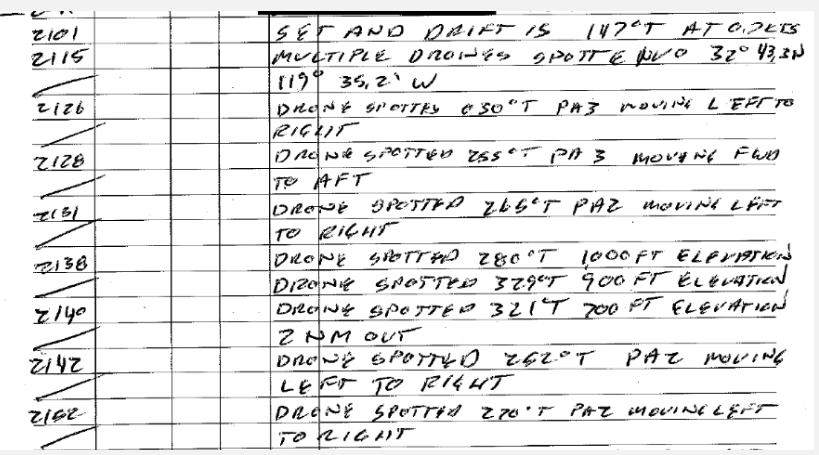
The logs describe drones dropping in elevation, and apparently moving forward and backward, left and right.
Meanwhile, the USS Rafael Peralta received a radio call from a passing cruise ship, the Carnival Imagination, notifying them that the drones are not theirs, and that they also see as many as five or six drones maneuvering nearby:

The incident continued into the night, with the USS Rafael Peralta first recording two UAVs and then four UAVs near their ship:
 Approaching midnight, the USS Russell reports a final sighting:
Approaching midnight, the USS Russell reports a final sighting:
 Despite the nearly three-hour duration of the event, none of the
warships involved appear to have been able to identify the drones.
Despite the nearly three-hour duration of the event, none of the
warships involved appear to have been able to identify the drones.

An Arleigh Burke destroyer underway at night.
In contrast to the first night, the second set of encounters occurred closer to shore. Several of the drone sightings placed their position between San Clemente Island and San Diego. The approximate positions of the ships and drone sightings are depicted below. Note that the track dots indicate the position of the ships throughout the event, with a larger black dot indicating the position of each ship near the start of the incident at 8:45 PM.
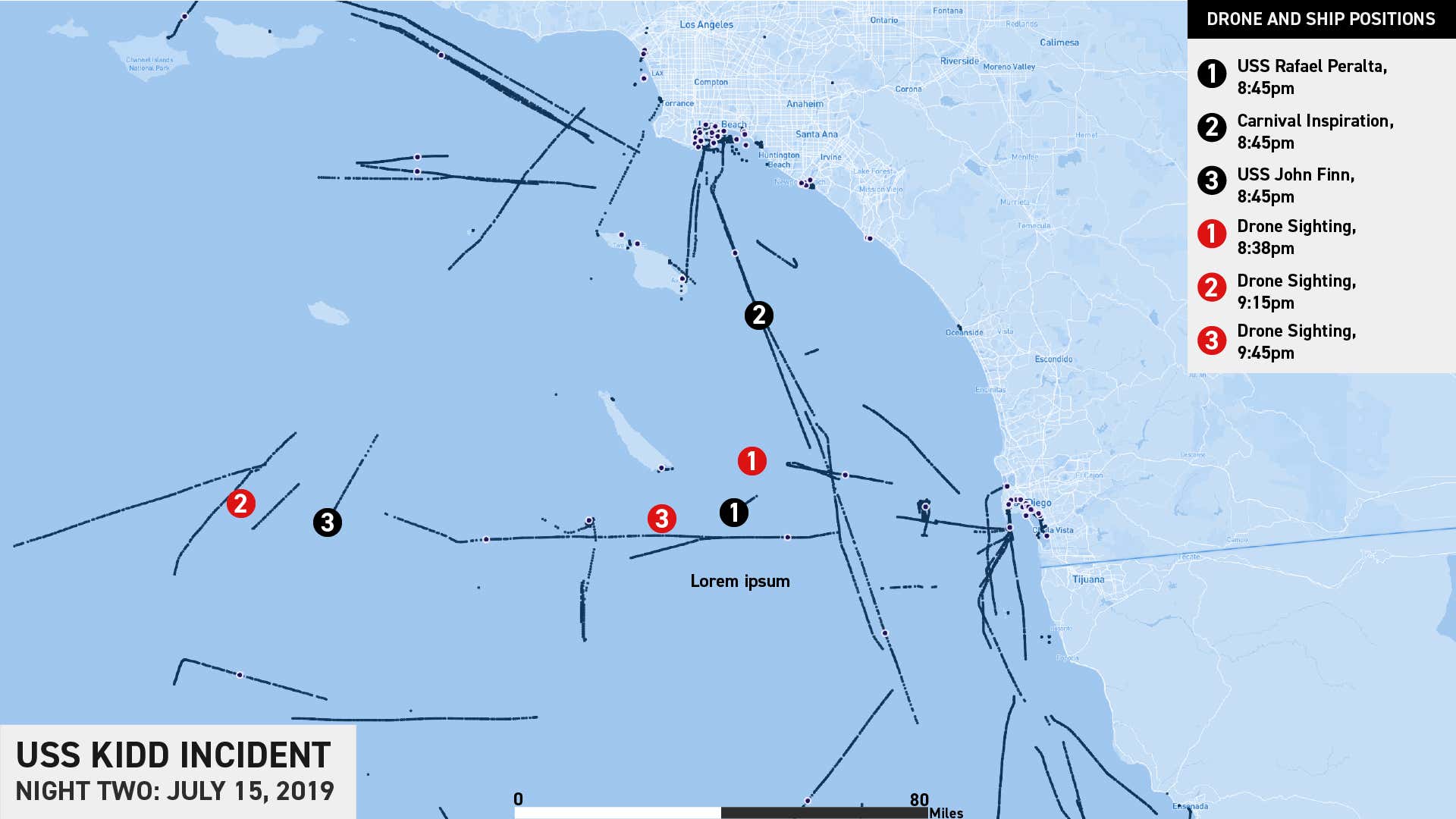
The Official Investigation
As might be expected for such an unusual set of encounters, a formal investigation appears to have been launched immediately. The first email we obtained was dated July 17th, and referenced earlier phone conversations.
By the morning of July 18th, a Navy liaison to the Coast Guard began requesting updates for information on vessels involved in the encounter, citing "higher-level visibility."
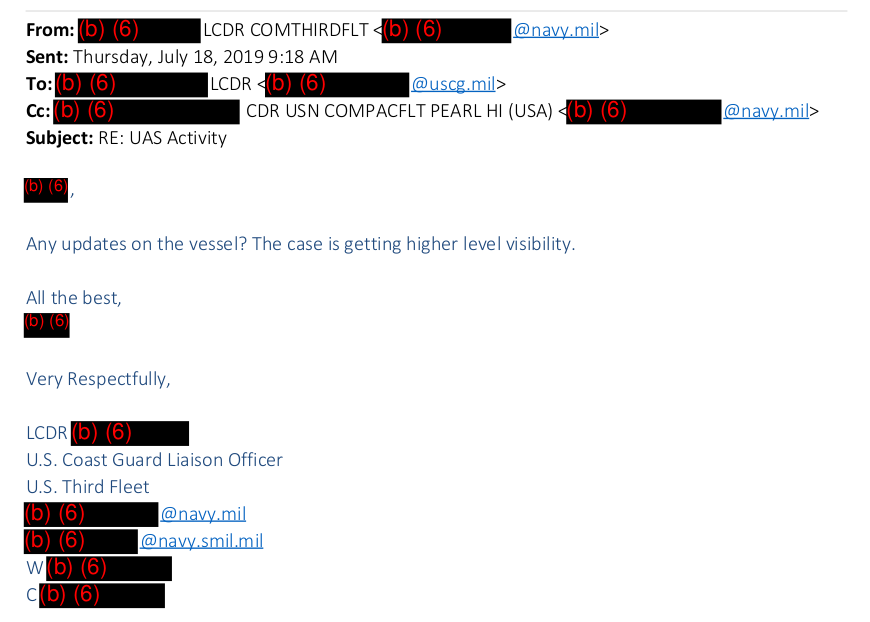
An hour later, a special agent with Naval Criminal Investigative Service (NCIS), assigned to 3rd Fleet as a "Staff CI Officer," with CI likely standing for "counter-intelligence," thanked a colleague in the Coast Guard. They mentioned that the information would go directly to the commander of the Pacific Fleet and to the Chief of Naval Operations (CNO) – the top of the Navy hierarchy, and a member of the Joint Chiefs of Staff.
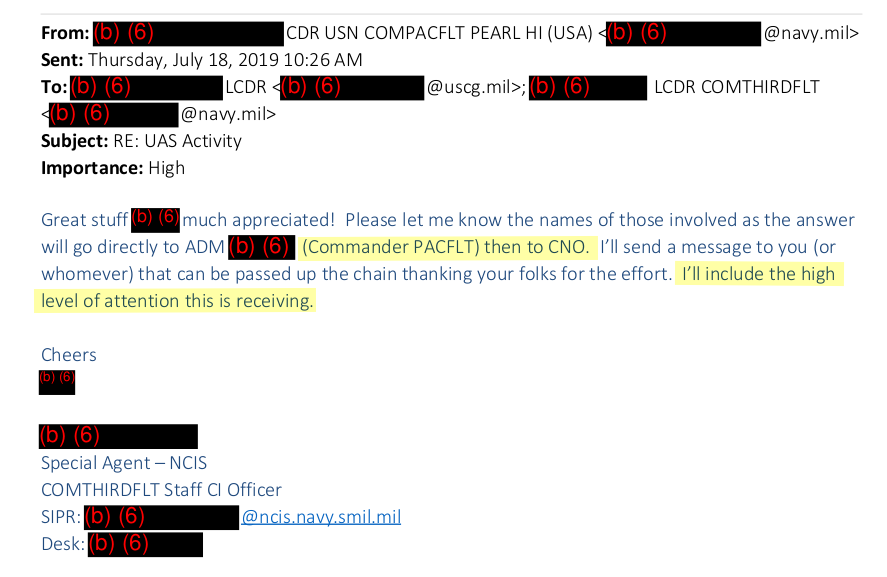
It appears the initial focus of their investigation was the ORV Alguita. An email sent just 10 minutes later expressed the need to relay information about the ship to a larger team.

By this time, an agent with the Los Angeles office of the FBI was included in the email chain. Preliminary information indicated that while the ORV Alguita did have drones onboard, they had very limited capabilities.
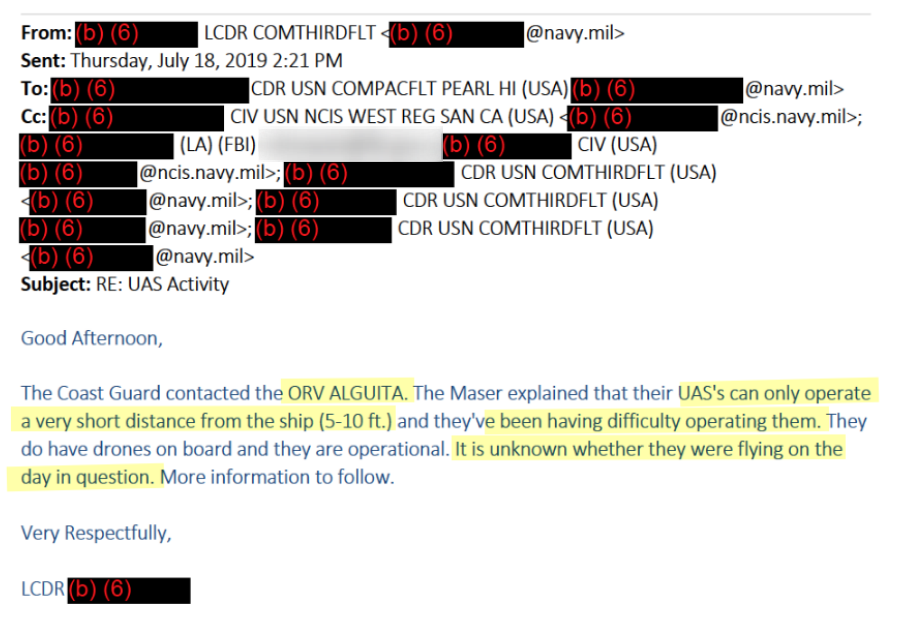
A follow-up email on the evening of July 18th indicated that the Coast Guard had contacted the ship directly via satellite phone. Based on the subject line reference to San Nicolas Island and the time period given by investigators, it seems the ORV Alguita was being examined specifically for the events of July 14th.
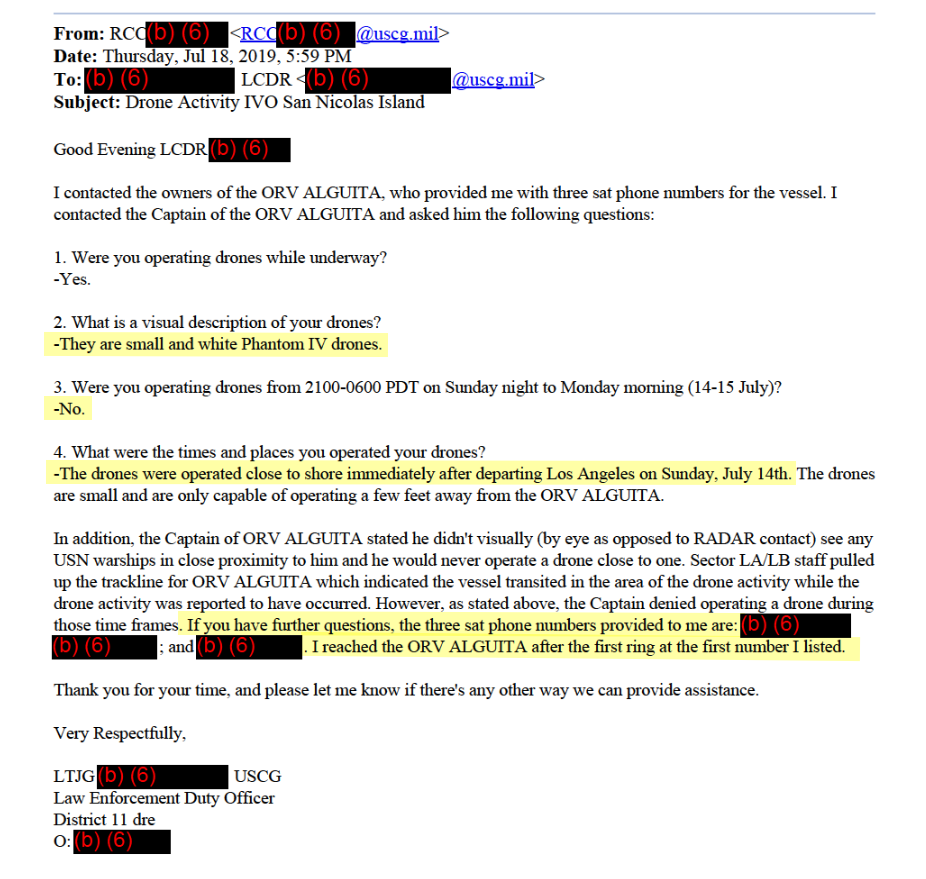 The investigators had encountered several problems at this point. The owners of the Alguita
denied operating a drone during the time in question, and claimed that
their drones were incapable of operating more than a few feet from the
ship. Further, the Phantom IV drone is a small quadcopter and has a
maximum flight time of 28 minutes, according to manufacturer DJI, which is inconsistent with the long durations of the incidents and general performance described as observed in the deck logs.
The investigators had encountered several problems at this point. The owners of the Alguita
denied operating a drone during the time in question, and claimed that
their drones were incapable of operating more than a few feet from the
ship. Further, the Phantom IV drone is a small quadcopter and has a
maximum flight time of 28 minutes, according to manufacturer DJI, which is inconsistent with the long durations of the incidents and general performance described as observed in the deck logs.
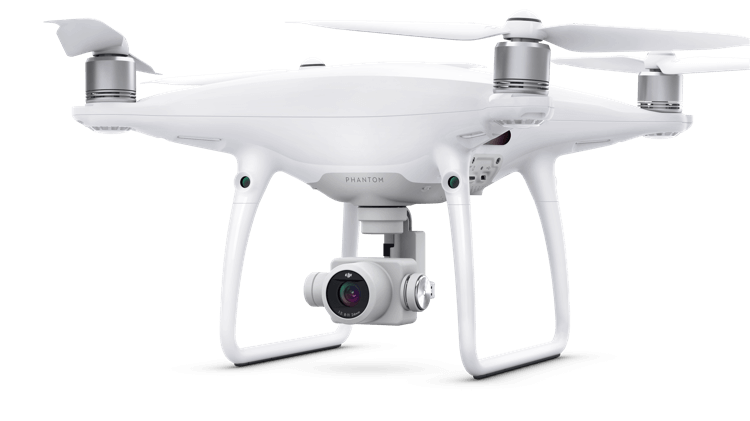
Phantom 4 Pro.
Although not referenced in these emails, the Alguita was also significantly west of the events of the second night, July 15th, based on AIS data. Apparently recognizing that ORV Alguita was a poor fit, investigators conceded that they needed to keep looking. Emails reflect that Navy intelligence began to take a more active role in the investigation by July 19th, with the director of the Maritime Intelligence Operations Center (MIOC) within 3rd Fleet, identified by the acronym C3F, "looping in" the rest of the command's intelligence office, or N2.
 Investigators next sought to rule out the possibility that the drones
were operated by the Navy itself. By Tuesday of the following week, a
representative from the Fleet Area Control and Surveillance Facility
(FACSFAC) based in San Diego clarified that UAVs were only operated by
the Navy in certain limited areas. They then provided the following map
of operational areas (OPAREAS) with a breakdown of platforms in use.
Investigators next sought to rule out the possibility that the drones
were operated by the Navy itself. By Tuesday of the following week, a
representative from the Fleet Area Control and Surveillance Facility
(FACSFAC) based in San Diego clarified that UAVs were only operated by
the Navy in certain limited areas. They then provided the following map
of operational areas (OPAREAS) with a breakdown of platforms in use.
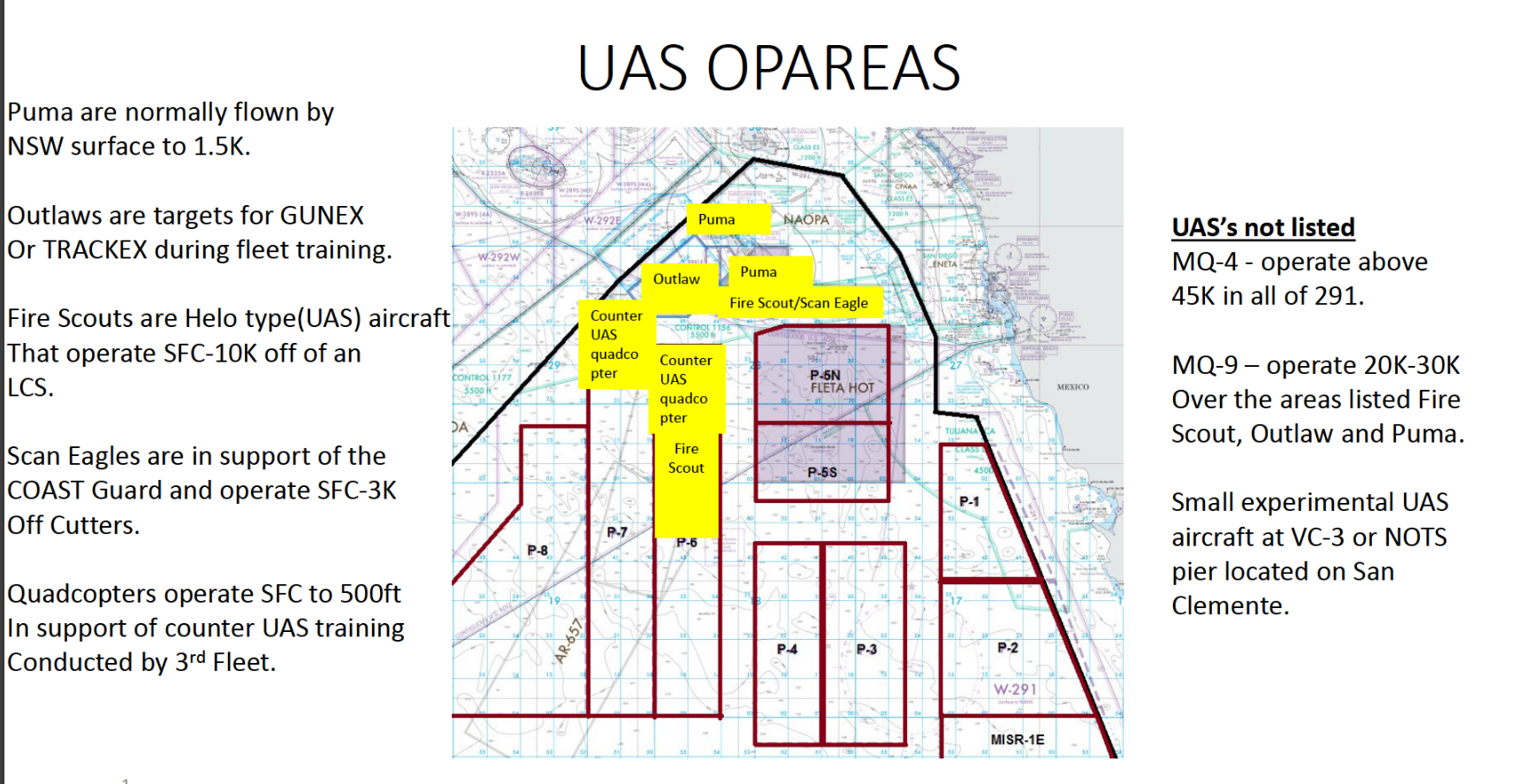 Somewhat cryptically, one of the investigators referenced "recent
observations" and further clarified the need to "correlate or rule out
operations." He further requested data detailing operations between the
14th to the 17th of July.
Somewhat cryptically, one of the investigators referenced "recent
observations" and further clarified the need to "correlate or rule out
operations." He further requested data detailing operations between the
14th to the 17th of July.
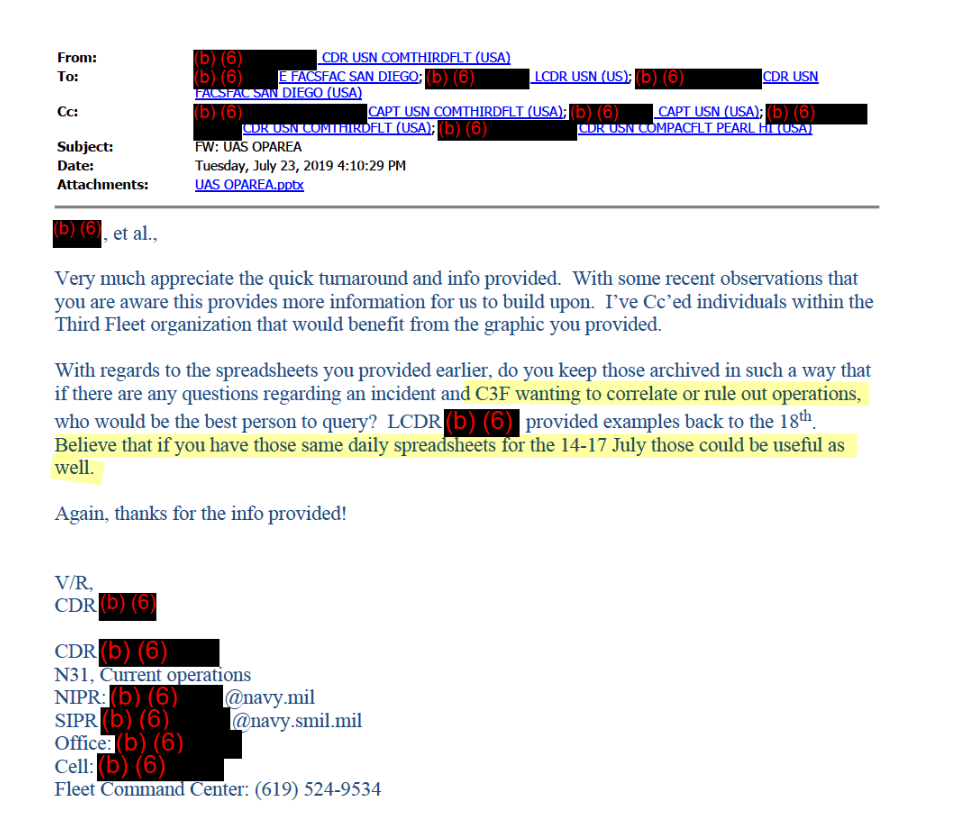 FACSFAC San Diego, in turn, sent spreadsheets of scheduled activity
during that time, and explained that UAV operations are highlighted in
yellow. Though the flight schedules released to us for July 14th are
completely redacted, the underlying highlighting is visible. No yellow
highlighting can be seen for July 14th:
FACSFAC San Diego, in turn, sent spreadsheets of scheduled activity
during that time, and explained that UAV operations are highlighted in
yellow. Though the flight schedules released to us for July 14th are
completely redacted, the underlying highlighting is visible. No yellow
highlighting can be seen for July 14th:
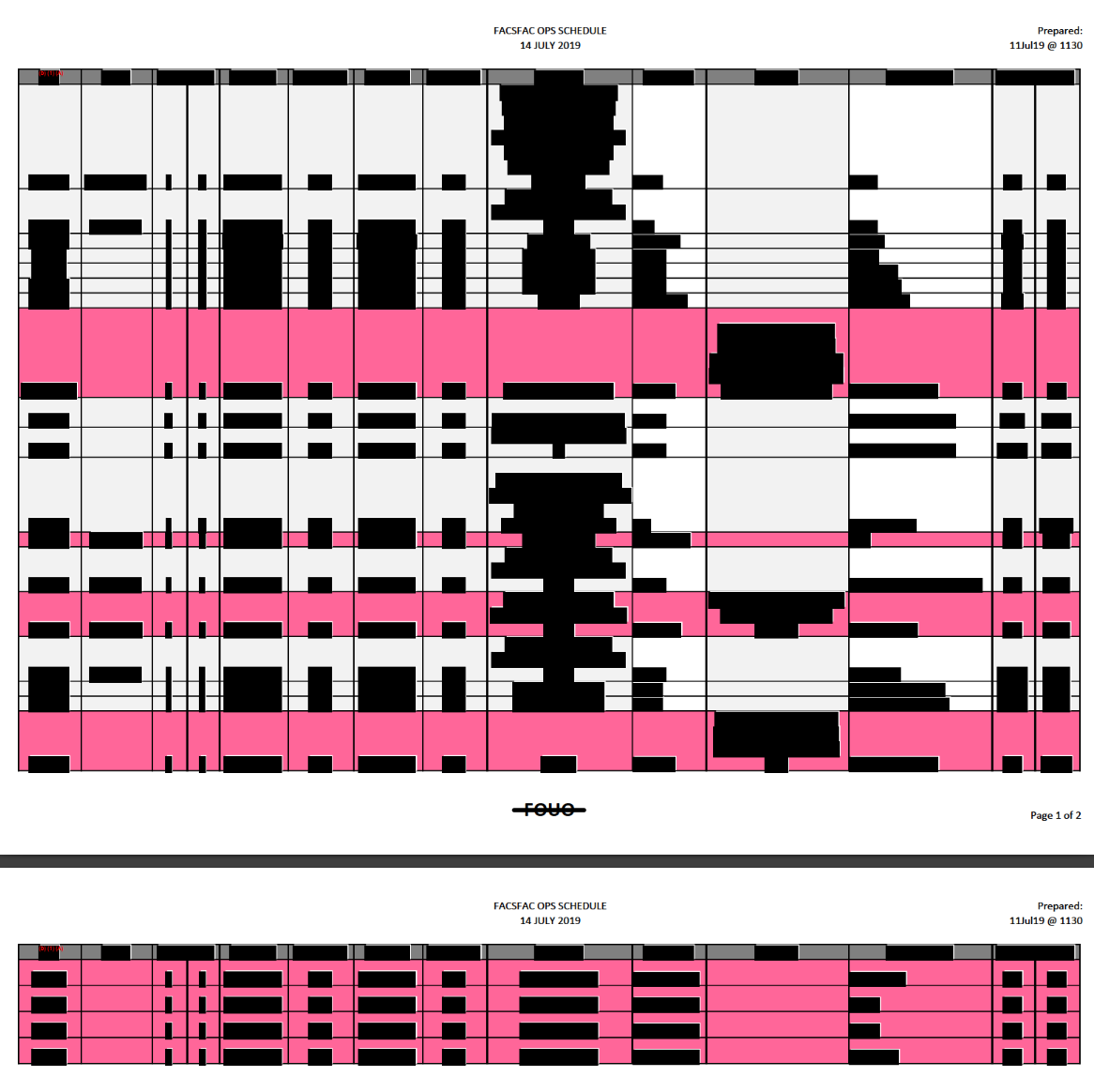
By the afternoon of July 23, the investigators were still grappling with determining the intent behind the incidents.
 The last email disclosed to us was from July 25th. It references a classified briefing on drones (referred to here as UAS).
The last email disclosed to us was from July 25th. It references a classified briefing on drones (referred to here as UAS).
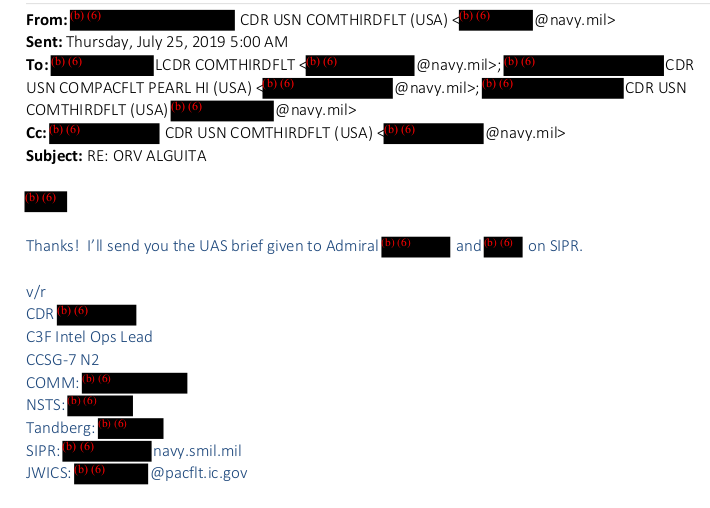
A further FOIA request for information about these briefings was denied due to their classification level. After July 25th, the email trail turns cold.
Remarkably, the drone incidents began occurring again around this time. Renewed sightings occurred during the early hours of July 25th and July 30th, just as investigators were beginning to examine classified briefings and were apparently still seeking to identify the intent behind the July 14th and 15th incursions.
The incident on the 25th involving the USS Kidd began around 1:20 AM, with the SNOOPIE team being deactivated around 1:52 AM.
 The incident on July 30th was longer, with the team activated around 2:15 AM and only deactivated by 3:27 AM:
The incident on July 30th was longer, with the team activated around 2:15 AM and only deactivated by 3:27 AM:


These later incidents are notable because they occurred during the investigation, and after FACSFAC San Diego had been closely consulted.
At the time of writing, we do not have complete deck logs for the month of July except for USS Kidd, so it remains uncertain if other ships also continued to have drone encounters later in the month.
Further information continues to emerge from FOIA requests, but based on the available evidence it appears that the initial investigation did not ultimately identify the source of the drones.
Increasingly Pressing Questions
Cumulatively, these new details raise a host of difficult questions.
It is unclear why anyone would operate drones near Navy warships in such a brazen manner. Commercially available drones are not commonly capable of flying for such long durations across great distances with speeds in excess of 45 miles an hour. Based on the pooled data available from the deck logs, we estimate the drones traversed at least 100 nautical miles in the July 14th incident.
Furthermore, the drones were able to locate and catch a destroyer traveling at 16 knots in conditions with less than one nautical mile of visibility. Equally baffling, their operators appear to have coordinated at least five to six drones simultaneously. Then there is the question of line-of-sight control, and control methods in general, which make the capabilities described all that much more puzzling.
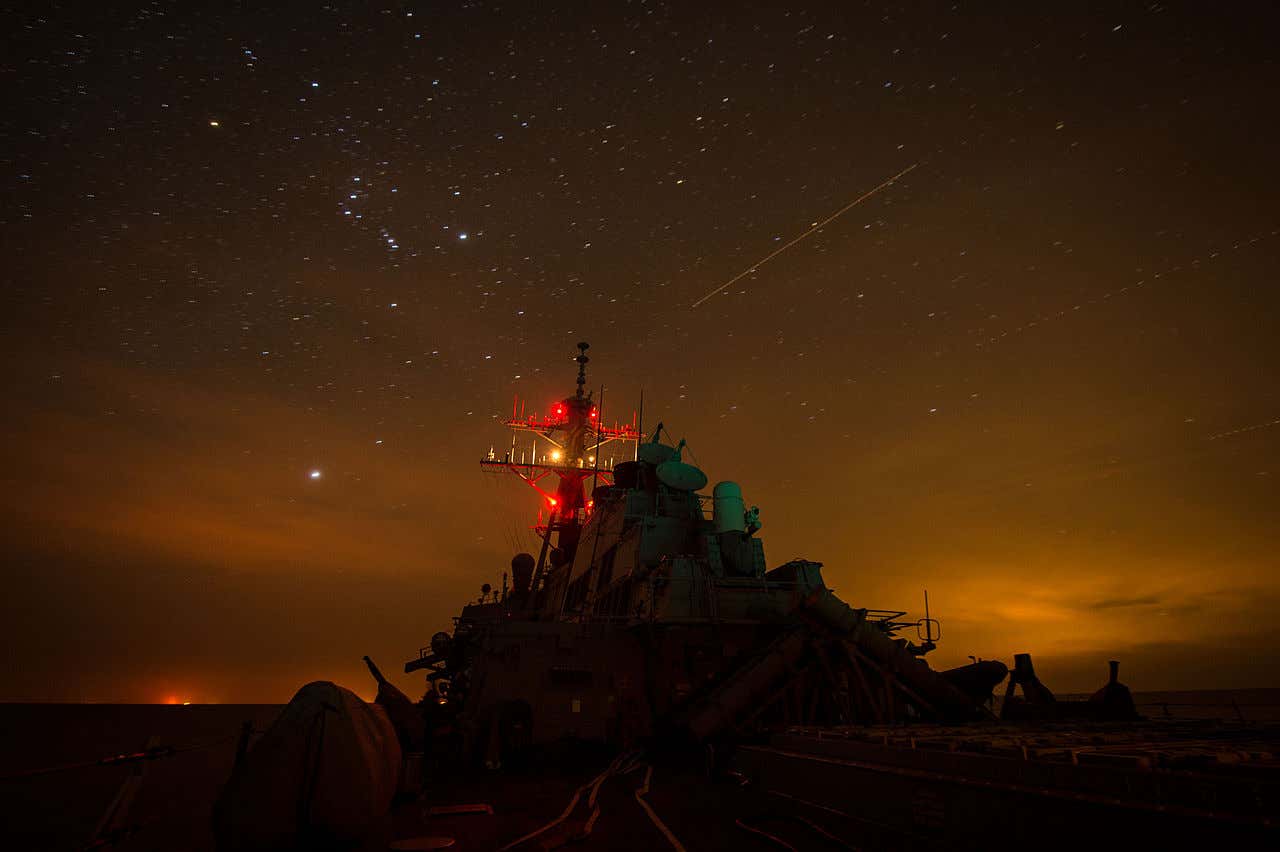
A U.S. Navy destroyer cruises under the stars.
To be sure, San Clemente Island and nearby training area FLETA HOT are hosts to a bevy of testing, which can include classified programs. Is it possible that the drones were operated by the military itself in an errant test of some kind?
If so, the incursions continued after a concerted investigation that reached the highest level of the Navy hierarchy. It also appears that no UAV activity was scheduled by FASFAC San Diego during July 14th. On the other hand, it is a general area where extremely strange things have occurred in the past.
If the drones were not operated by the American military, these incidents represent a highly significant security breach. If they were part of some kind of covert action, it is nonetheless unclear why they were flown so openly and so frequently in almost a harassing manner. More troubling still, if a foreign state actor was involved, where exactly were the drones launched from?
One thing is fairly sure: the U.S. Navy has a large amount of data on these events. The documents above reflect that multiple independent photographic intelligence teams were deployed. These teams are only a small part of a sophisticated suite of surveillance capabilities and advanced sensors, including the ability to detect radio emissions in the vessels’ vicinity, available to any one of the ships involved. This is on top of the land-based sensors that closely surveil the area. In fact, it is puzzling that those sensors, coupled with a likely extensive photographic record, were not sufficient in and of themselves to resolve the matter. This calls into question the “drone” designation. Was there ever even a hard description of these craft beyond lights in the sky?
The question remains: who was operating these craft with apparent impunity, and for what purpose, and was this extremely bizarre case ever resolved?
Our investigation is into this event is still underway and we will update you as soon as more information becomes available.
Adam Kehoe and Marc Cecotti
Technosignatures of Intelligent Aliens Could Be “Lurking” Nearby, Study Says

A group of researchers propose searching for "unusual signatures or phenomena" on the Moon, and even around Earth.
With the ever-quickening pace of modern space exploration, humankind’s aspirations to explore other worlds–and possibly even find evidence of extraterrestrial life–have seen a number of upgrades. NASA’s Mars rover Perseverance is currently equipped with the most advanced astrobiology lab humans have ever sent to another planet, and while the nuclear-powered robot carries out its mission to search for possible signs of life, astronomers here on Earth are employing new technologies to peer across space at potentially habitable worlds, in search of the technosignatures of intelligent civilizations.
The search for technosignatures–detectable evidence of technologies produced by intelligent life on other worlds–has seen rising interest in the last few years by scientists, as well as members of Congress. Now, a recent NASA-funded study has just proposed a number of new ways that evidence of such civilizations might be detected in the years ahead.
The paper, which appeared in the journal Acta Astronautica, proposes several novel ideas about where scientists might search for evidence of intelligent extraterrestrials, not all of which involve life on planets far distant from Earth. In fact, the team of scientists has proposed that some of the most fruitful places humans could be looking for evidence of alien life may be far closer to home.

(Credit: Unsplash)
Mission Proposals for Spotting Technosignatures
“New and unique opportunities now exist to look for technosignatures (TS) beyond traditional SETI radio searches,” according to the study’s authors, which they say has been driven “by tremendous advances in exoplanet science and observing capabilities in recent years.” Such advances, the researchers say, may be of special significance to government space agencies like NASA, as well as private commercial space endeavors that have become increasingly active in recent years.
“We put forward a set of possible mission concepts designed to search for [technosignatures], although the data supplied by such missions would also benefit other areas of astrophysics,” the team’s study says.
Among the missions outlined in the study, the researchers propose a search for evidence of impact sites or other artifacts that might be present on the Moon, which might have resulted from intelligent probes or other extraterrestrial flotsam and jetsam that might have made its way there over the course of the last several millions, or even billions of years.

NASA artist’s concept of future lunar exploration of a cave feature on the moon (NASA/Public Domain).
Could it even be possible to search for such potential technosignatures on or around the moon with high-resolution imagery we already have on hand?
“It is certainly possible,” says Dr. Ravi Kopparapu, a research scientist at NASA Goddard Space Flight Center and one of the study’s coauthors. However, Kopparapu told The Debrief that maybe we shouldn’t limit the search for unusual technologies or other phenomena to the lunar surface.
“I would even say to look at the near-Earth orbit for any anomalous signature that appears at odds with our expectation or doesn’t fit the known data,” Kopparapu told The Debrief in an email. “Just like we are sending probes (like Voyager and pioneer spacecrafts) beyond our solar system, it is quite possible that other technological civilizations will do the same.”
“We are not unique in that sense,” he added.
In 2012, Kopparapu and his colleague Jacob Haqq-Misra coauthored a paper which explored this idea, where they argued that various kinds of extraterrestrial technology could already exist here in our Solar System. As they said in the 2012 paper, “the vastness of space, combined with our limited searches to date, implies that any remote unpiloted exploratory probes of extraterrestrial origin would likely remain unnoticed.”
“I think looking around our Earth’s surroundings (including the Moon) is very worthwhile to see if we find any unusual signatures or phenomena,” Kopparapu told The Debrief.

Image: NASA
Extraterrestrial Technology “Lurking” Nearby?
Another of the missions the team outlined in the recent Acta Astronautica paper involves searching for what they term “lurkers,” which involve prospective technologies that might be hidden on natural space objects like asteroids. Kopparapu thinks radio searches might be one way such “lurkers” could be detected, proposing that future searches might try reflecting radio signals off of asteroids, or even listening to see if any discernible transmissions are emanating from them.
“Maybe albedo differences (reflected light from the surfaces of objects on asteroids and see if they are consistent with the light reflected from the asteroid itself) is another method,” Kopparapu told The Debrief. However, in addition to technologies hidden on asteroids, the team also suggests the potential that such “lurkers” might actually be disguised as natural objects.
Kopparapu proposes monitoring asteroids to see if there are any deviations in their velocities, although he thinks it “will be hard to distinguish which one is a natural asteroid and which one is not.”
The study also includes more conventional approaches in its proposed missions in search of technosignatures, which include searching for evidence of pollution around more distant exoplanets, detection of possible Dyson spheres, the placement of a radio telescope on the far side of the Moon, all-sky searches for laser beam emissions, and focused studies of future interstellar visitors similar to the mysterious ‘Oumuamua.

This artist’s impression shows the
first interstellar object discovered in the Solar System, `Oumuamua
(Image Source: European Space Agency).
Perhaps most importantly, the researchers say that existing data that is already available to scientists should be examined for possible technosignatures. Similar ideas have been proposed in the past, which propose the use of searchable image collections obtained throughout the last several decades of space studies, as well as databases and other information which “all offer low-cost opportunities to seek a footprint of extraterrestrial technology.”
Looking Ahead: Technosignatures and the Future
Of course, even the best of what we have available today may not compare to new technologies that could aid with the detection of technosignatures in the years ahead.
Kopparapu says it all depends on “what is available now and what facilities will be available in the near future.”
“Essentially, what kind of detection methods and telescopes are upcoming that we can use, other than radio searches, to look for technosignatures on other planets? We have James Webb Space Telescope (JWST) to be launched in this year that could look at the atmospheres of exoplanets. We also have next generation space telescope mission concept studies like LUVOIR, HabEX and OST that look at the atmospheres of exoplanets to find signs of life.”

An artist’s rendition of the James Webb Telescope (Image: ESA/NASA)
“We could use the same telescopes for identifying technosignatures in the atmospheres of distant worlds,” Kopparapu says, noting that while the years ahead may afford us some exciting, and even a few unforeseen opportunities, our most productive searches will be reliant on what we can probably already expect to have within the next few years.
“So the question of what are the most promising methods boils down to what are we going to have access to in the near-term,” Kopparapu told The Debrief. “And because the above-mentioned telescopes are the ones we will have access to, it makes sense to use those to look for technosignatures.”
However, a few of the more “traditional” technologies that have been employed in the search for extraterrestrial intelligence over the years shouldn’t fall to the wayside.
“Radio searches can—and should—continue,” Kopparapu emphasized.
“If we do detect a radio signal that is confirmed to be not-natural, and not-from Earth, then things get interesting.”
The study, “Concepts for future missions to search for technosignatures” by authors Hector Socas-Navarro, Ravi Kopparapu, et al, appeared in the May 2021 issue of Acta Astronautica.
Micha Hanks
“It isn’t Ours.” Marco Rubio Says the Government is Taking Unidentified Aerial Phenomena Seriously

Florida Senator and Chair of the Senate Intelligence Committee Marco Rubio became the latest member of the U.S. government to weigh in on the subject of unidentified aerial phenomena (UAP) on Wednesday, saying that the “stigma” associated with the subject has hindered efforts toward studying it.
“We have things flying over military installations, over military exercises, and other places, and we don’t know what it is,” Rubio said during an early Wednesday appearance on Fox Business Network’s Mornings with Maria Bartiromo.
“It isn’t ours. It isn’t anything that’s registered to the FAA, and in many cases exhibits attributes of things we’ve never seen,” Rubio said of unidentified aerial phenomena being studied currently by a Task Force run out of the Pentagon and the Department of the Navy.
Rubio adds that he feels it is important that the U.S. government attempt to ascertain what the phenomena in question may represent, “without any preconceived notions.”
“Maybe there’s a logical explanation,” he added, acknowledging the possibility that some unidentified aerial phenomena observed by Navy pilots and others in government could represent “a foreign adversary that’s made a technological leap,” a possibility that was suggested during a recent appearance former Director of National Intelligence John Ratcliffe made on Bartiromo’s program.
Last August, the Pentagon announced the establishment of an Unidentified Aerial Phenomena (UAP) Task Force (UAPTF), according to a DoD statement. “The Department of the Navy, under the cognizance of the Office of the Under Secretary of Defense for Intelligence and Security, will lead the UAPTF,” the statement read.

Credit: James N. Mattis/CC 3.0)
“The Department of Defense and the military departments take any incursions by unauthorized aircraft into our training ranges or designated airspace very seriously and examine each report,” the Pentagon statement read. “This includes examinations of incursions that are initially reported as UAP when the observer cannot immediately identify what he or she is observing.”
As far as the possibility that some of the unidentified aerial phenomena the UAP Task Force is studying could have exotic origins, Rubio says we “don’t have to go that far.”
“It’s simple,” Rubio told Bartiromo. “There are things flying over national security installations, we don’t know who they are, we don’t know what it is, it isn’t ours, [and] we need to find out.”
With the passing of the FY 2021 Intelligence Authorization Act earlier this year, the UAP Task Force was given the greenlight to produce a report within 180 days about its findings. However, Rubio told Bartiromo he isn’t certain that the report will be ready by the time of the 180-day deadline. He added that once the report does appear, that doesn’t necessarily mean it will contain conclusive information about the possible nature and origins of the UAP Task Force is studying.
“I don’t know if we’re gonna know,” Rubio said. “I’m not sure that by June 1 they’ll have reached a hard conclusion about what they’re dealing with, and there may be more questions—or new questions—than full answers after the fact.”
Rubio added that the UAP subject is “being taken more seriously now that it ever has been,” despite the prevailing stigmas against it that persist.

The Florida Senator’s statements on Wednesday marked his second acknowledgement in recent days of attitudes toward the UAP subject that may have hindered its serious study. On Monday, a TMZ reporter questioned Rubio briefly on camera, where the politician said that “no one wants to sound weird.”
Since 2020, Rubio has played an active role in spearheading government efforts toward the study of unidentified aerial phenomena. Last summer, a provision contained within the annual intelligence authorization bill produced by Rubio and the Senate Intelligence Committee officially requested the establishment of a task force, advising that it conduct a comprehensive review of UFO-related material from several different branches of government.
However, information obtained by The Debrief via Freedom of Information Act Requests revealed that officials that included the Vice Chiefs of Staff for the Navy and Air Force had been given classified briefings about UAP at least as early as October 2019. It was also learned by The Debrief that that at least two classified intelligence reports involving military encounters with UAP had been circulated within the Intelligence Community since 2019.
In an interview last July with CBS Miami’s Jim DeFede, Rubio appeared to confirm that the U.S. government has spent many years looking at information it has collected on UAP. As Rubio said during the July 2020 interview, the Office of Naval Intelligence has “seen reports on this now for the better part of a decade,” and that “other countries have had similar reports.”
When asked on Monday if he thinks UFOs might represent a threat, Rubio advised taking things “one step at a time.”
“I’m not saying that’s what it’s all about,” the Senator said, adding that he believes the military would admit it if they had reached any definitive conclusions about whether UAPs might represent a form of technology, and if so, what that could mean.
“I think they’d tell us what’s going on,” Rubio said, though he added that based on what information he has seen, the military doesn’t know what it is.
“So that’s a problem. We need to find out if we can.”
Micah Hanks
International UFO Investigation Organization Sets Up Permanent Headquarters in Ohio

The truth is out there.
And possibly literally right here in the Ohio, as Cincinnati is once again home to nonprofit UFO investigation organization Mutual UFO Network, or MUFON.Launched in 1969, MUFON has three goals, which its more than 600 trained
investigators and 4,200 members across the world enact:
- Investigate UFO sightings and collect the data in the MUFON Database for use by researchers worldwide.
- Promote research on UFOs to discover the true nature of the phenomenon, with an eye towards scientific breakthroughs, and improving life on our planet.
- Educate the public on the UFO phenomenon and its potential impact on society.
Although the organization has moved several times since its founding,
it left Cincinnati in 2012 to relocate to Irvine, California. Now, its
board of directors has declared MUFON is permanently returning to the
Queen City, setting up headquarters near Lunken Airport.
Historically, MUFON has moved to wherever its executive director is
located; current executive director David MacDonald is based out of
Cincinnati. (MacDonald also previously served as director, hence MUFON's
former stint in the city.)
"Cincinnati is within a six-hour drive to 80% of the nation. It is
also highly valued due to its many advantages to business," MacDonald
tells Scene. "Cincinnati is remarkably less expensive to live in as well
as do business in than Southern California. One of Cincinnati’s largest
corporate headquarters once said, 'We have two problems to being in
Cincinnati — one is to get people to move here, the second is getting
them to leave.'”
But besides the logistics, MacDonald says making the move to
Cincinnati permanent is valuable because the area has a special
connection to UFOs.
"Wright Patterson is 45 minutes away," he says. "There are quite a few
sightings in the Tri-State area, and it was the home of one of the most
famous UFO pioneers in the world, Len Stringfield."
MUFON is "actively recruiting" more UFO hunters and has a spot on its website where the public can report UFO sightings.
But to be a field investigator takes more than mild curiosity.
MacDonald says investigators are "the foundation of MUFON." Ideal
candidates are stable, dependable and objective with hours of volunteer
time available and have "an above-average interest in the UFO
phenomenon."
Each candidate has to pass a background check, attend MUFON University
training online and take an exam before becoming an official trainee.
After that, the trainee must shadow a professional investigator before
they're allowed out in the field alone.
The end goal is to "collect accurate data for entry into the MUFON
CMS, which will then be used in MUFON research," says MacDonald.
"This is one of the most exciting times for MUFON. For 52 years, we've
searched for the truth about UFOs and now it is breaking," he says.
"Around 2018, the now-famous 'Tic Tac' videos
were released. Recently, the United States government is being directed
to release their classified information where it has been confirmed
that a UFO (not a missile) flew over a commercial airliner near White Sands. An Israeli professor who was a high-ranking intelligence officer, publicly disclosed that UFOs are not only real,
but they are here. But the blockbuster came a few weeks ago when the
Pentagon acknowledged that they do in fact have crash debris from UFOs."
Former director of national intelligence says upcoming Pentagon UFO report reveals technology ‘we don’t have’

WASHINGTON - The massive $2.3 trillion coronavirus relief package signed by former President Donald Trump into law in 2020 triggered a countdown to a deadline by which the director of national intelligence and the secretary of defense must provide lawmakers a report on what is known about UFOs.
Buried within the thousands of pages of legislation under the "Committee Comments" section of the Intelligence Authorization Act for Fiscal Year 2021, a stipulation requested a report to senators on intelligence and armed services committees regarding any information surrounding UFO sightings and whether they present any potential threat.
While the exact nature of the purported extraterrestrial threats were previously unknown, former Director of National Intelligence John Ratcliffe spoke with FOX News’ Maria Bartiromo on Monday, saying "there are a lot more sightings" than the public is aware of.
Ratcliffe said there have been objects observed by U.S. military craft and satellites that have achieved forms of flight that would normally be impossible with any known human technology.
"When we
talk about sightings, we are talking about objects that have seen by
Navy or Air Force pilots, or have been picked up by satellite imagery
that frankly engage in actions that are difficult to explain," he
continued.
"Movements that are hard to replicate that we don't
have the technology for. Or traveling at speeds that exceed the sound
barrier without a sonic boom," Ratcliffe explained.
According to the stipulation within the legislation, the information is sought out by a government program known as the Unidentified Aerial Phenomenon (UAP) Task Force.
"The Committee further directs that, within 180 days
of enactment of this Act, such individual shall develop a strategy for
security and counterintelligence collection that defines the capability
requirements, responsibilities, and processes for security and
counterintelligence for domestic military installations and other
domestic military facilities," according to the legislation.
The Select Committee on Intelligence wrote that the report must include:
- "A detailed analysis of unidentified aerial phenomena data and intelligence reporting"
- "A detailed analysis of unidentified phenomena data"
- "A detailed analysis of data of the FBI, which was derived from investigations of intrusions of unidentified aerial phenomena data over restricted United States airspace"
The report is expected to reach the Senate’s hands by the end of June.
Last
year, the U.S. government declassified and released videos which show
encounters between UFOs and U.S. Navy pilots in 2004 and 2015.
In September, the U.S. Navy acknowledged
that videos showing the 2004 and 2015 UFO encounters by U.S. Navy
pilots were released by former Blink-182 singer Tom DeLonge and
published by The New York Times were of real "unidentified" objects.
"The Navy considers the phenomena contained/depicted in those three videos as unidentified," Navy spokesman Joseph Gradisher told The Black Vault, a website dedicated to declassified government documents.
After the release of the videos, reports surfaced of a top-secret Pentagon program conducting classified briefings for more than a decade, analyzing various encounters between military craft and unidentified aerial vehicles.
In July, the Pentagon stated that the program was disbanded, but a Senate committee report from June revealed spending on a program called the Unidentified Aerial Phenomenon Task Force.
FOX
Television Stations reported in June of last year that U.S. Sen. Marco
Rubio had requested a detailed analysis on the findings of the task
force.
The reveal of both the task force’s existence, as well as Rubio’s data request, came in a June 17 Select Committee on Intelligence report authored by Rubio on the Intelligence Authorization Act.
In regards to Ratcliffe’s comments on unexplained technology observed by U.S. military personnel and detailed in the upcoming report, at least one scientist can attest to having observed something similar.
Astrophysicist and former consultant for the UFO program since 2007, Eric W. Davis, told the New York Times in July of last year that he gave a classified briefing to the Defense Department agency in March 2020 regarding "off-world vehicles not made on this Earth."
La pandemia fa sparire anche gli Ufo ( Ma che dice questo: durante la pandemia gi avvistamenti sono aumentati in maniera esponenziale )

Villagrossi: «In periodi come questo si smette di indagare su misteri intriganti»
SONCINO (24 marzo 2021) - Nel borgo sull’Oglio le navi spaziali (o presunte tali) venivano avvistate tra settembre e marzo ogni anno, dal 2013 a oggi. Adesso però c’è il virus, quindi nessuno si preoccupa più degli omini grigi che non si vedono dai primi giorni del 2020. Per Aldo Villagrossi, ingegnere soncinese, ricercatore e già dirigente per case farmaceutiche e cosmetiche con la passione per l’indagine sul campo ma che ai Rettiliani e ai Marziani non ci crede, il mistero è presto svelato: «Perché a Soncino non ci sono più gli Ufo? – ironizza – Forse perché quando si cerca di sopravvivere si smette di cercare il mistero intrigante». Ma occhio a generalizzare, dicendo che ogni oggetto volante non identificato sia per forza una baggianata: «Scetticismo a priori e creduloneria – spiega– sono due facce della stessa medaglia. La frivolezza non è necessariamente sinonimo di qualcosa di falso. Va solo capita e spiegata».
Fonte
Commento di Oliviero Mannucci: Ecco un altro genio! Gente che di ufologia non sa un emerita minchia che dovrebbe lasciar stare di fare commenti su cose che non conosce minimamente. Gli avvistamenti durante la pandemia sono aumentati in tutto il mondo in maniera considerevole. Questa sotto è una delle notizie che consiglio di leggere al "genio di turno" che parla a sproposito su cose che non conosce.
UFO, a inizio del 2021 non si placano gli avvistamenti in Italia: "E' del tutto inspiegabile"
UFO report might miss deadline according to Senator Rubio

MYSTERY WIRE — One day after talking to a TMZ photographer about UFOs and the highly anticipated UAP report that is supposed to be submitted by U.S. intelligence agencies by June 1st, Sen. Marco Rubio (R-FL) told Fox Business he is “not sure they’re gonna come in on time.”
But the clock remains ticking for the Pentagon’s hush-hush program to investigate UFOs and the other intelligence agencies included in the request.
At the Pentagon, it’s called the Unidentified Aerial Phenomena Task Force (UAPTF), and it has been ordered to prepare a detailed overview of the UFO mystery for submission to Congress.
However, as Sen. Rubio mentioned, there are already challenges to meeting this deadline.
The first public mention of the UAPTF came in June 2020 when the Senate Intelligence Committee formally asked the Pentagon for a comprehensive analysis of the UFO mystery.
Over the previous three years, members and staff of key committees had received closed door briefings about startling encounters between the U.S. military and UAPs.
Sen. Rubio has acknowledged to Mystery Wire that lawmakers consider this to be a serious matter.
Late last week, John Ratcliffe, the top intelligence official under former President Donald Trump, explained that the forthcoming report will outline “a lot more sightings than have been made public.”
“Some of those have been declassified,” Ratcliffe said during the interview.
A spokesperson for current DNI Avril Haines told politico.com that “we are aware of the requirement and will respond accordingly.”
Below is the transcript of the UFO discussion between Fox Business host Maria Bartiromo and Sen. Marco Rubio.
Maria Bartiromo
Senator, I want to turn to unidentified objects in the air, I had an exclusive interview with the former director of national intelligence, john Radcliffe, the other night on Fox News, where I asked him about this upcoming Pentagon report, which you of course have commissioned or encouraged to have a report on these unidentified objects.
Have unidentified flying objects been seen?
Sen. Marco Rubio
We’re sure we have lots of reports about what we call unidentified aerial phenomenon. There are a lot more sightings then have been made public. Sometimes we wonder whether or not our adversaries have technologies that are a little bit further down the road than we thought or that we realized.
Maria Bartiromo
So Senator, what about that? What can you tell us about UFOs?
Sen. Marco Rubio
Well, we have things flying over military installations over military exercises and other places. And we don’t know what it is. It isn’t ours. It isn’t anything that’s registered with the FAA, and in many cases, exhibits attributes of things. We’ve never seen technology, the kinds of technology we haven’t seen before. At least that’s what it seems like. I think you have to know what it is, or we have to try to know what it is. That’s my view of it without any preconceived notions, maybe there’s a logical explanation. Maybe it’s a, you know, something that can be explained away. Maybe it’s a foreign adversary who’s made a technological leap, as you’ve heard the former DNI said, whatever it is, we need to know the answer to it. The problem with this issue is every time you raise it, people get all nervous. Oh, does this mean UFOs and aliens and extraterrestrials? We don’t have to go So far, it’s very simple. There are things flying over national security installations. We don’t know who they are. I don’t know what it is it isn’t ours, we need to find out.
Maria Bartiromo
Well, this is absolutely fascinating. So I mean, from, from my standpoint, when I heard john Radcliffe talk about that, I went and I looked up what you’ve said about the Pentagon report coming up June 1, what do you think we’re going to learn from that Pentagon report on June 1?
Sen. Marco Rubio
Well, first, I’m not sure they’re gonna come in on time to be honest with you, because they miss a lot of deadlines and government on these sorts of things. But we’ll get a report at some point. Second is I don’t know if we’re going to know what I mean, I’m not sure that by June 1, they’ll have reached a hard conclusion about what they’re dealing with. And there may be more questions or new questions than than full answers after the fact. I can tell you it’s being taken more seriously now than it ever has been. And look, there’s a stigma associated with this. All right, when at when a Navy pilot would report that they saw something, they were told, you need to go see the flight surgeon, you know, so to check out your head, you know, make sure you’re not seeing things. So there’s a stigma associated with reporting it, even talking to you about it now, right? I mean, people are going to go and say, Look what these people are focused on when the world is falling apart. So there’s a there’s a stigma associated with it. And that’s, I think, needs to go away. We don’t have any preconceived notions about what this is or isn’t. We just need to know or we need to start we need to start trying to know, I think the first step is to ask the question, if you don’t ask the question, you’re not going to begin to get answers.
Maria Bartiromo
So it’s not necessarily like that we have, you know, little ETs running around aliens, but it could be technology that China or Russia or somebody else has developed that could be ahead of the United States, then that’s even more worrying worrisome to me.
Sen. Marco Rubio
Again, I don’t know it would be very worrisome. I don’t know that to be the case, but we need to start finding out.